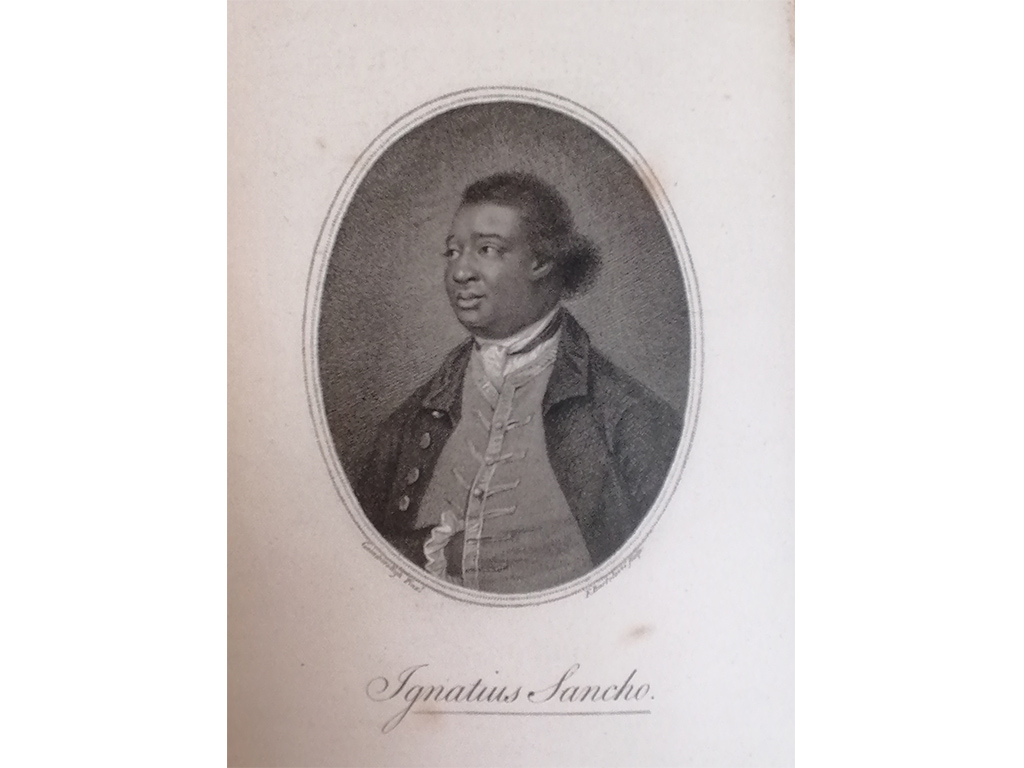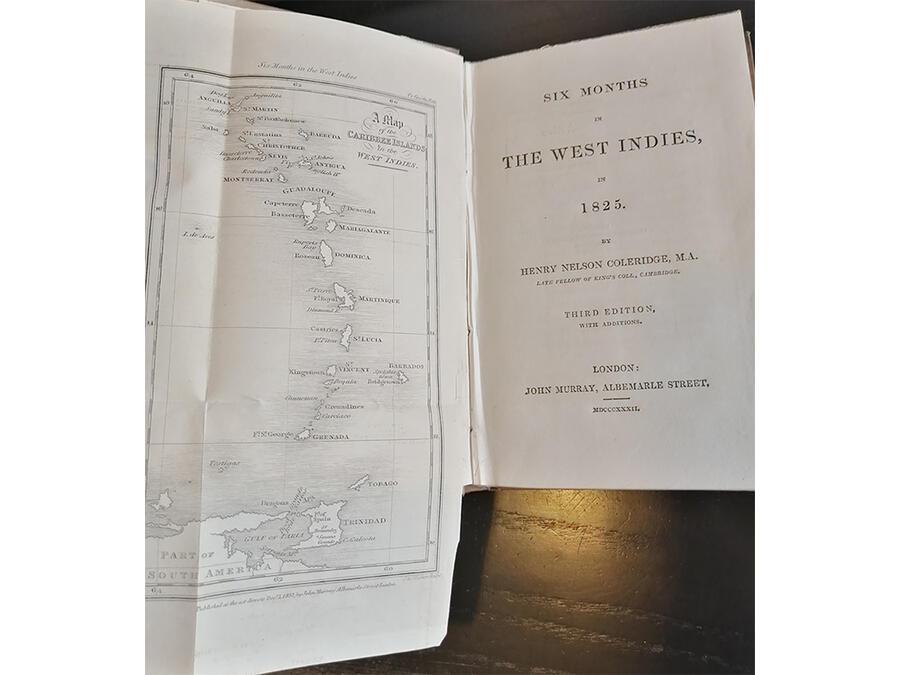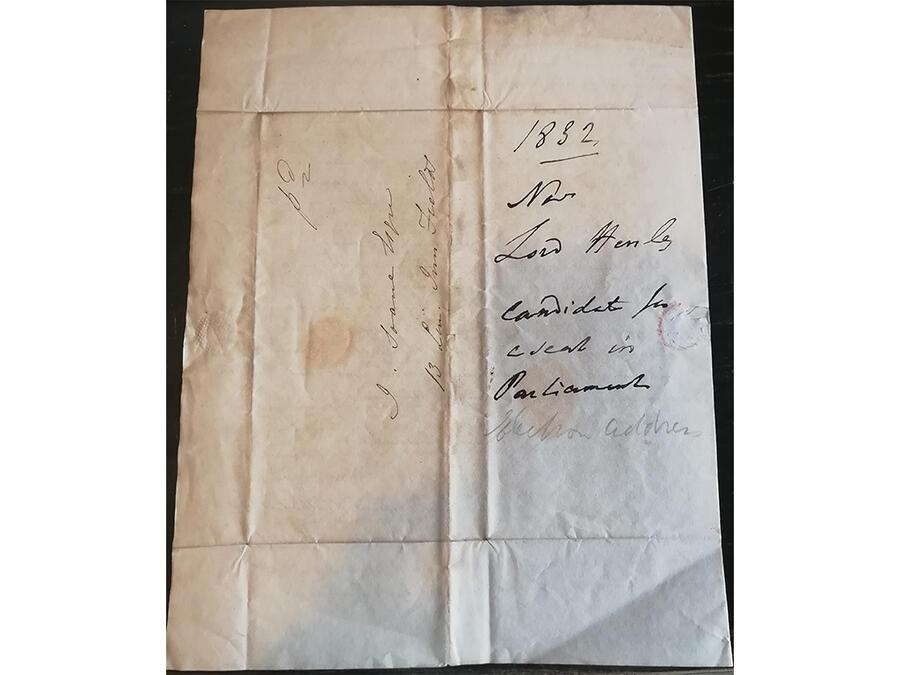Frances Crewe (ed.), Letters of the late Ignatius Sancho…, 1st edition, 1782, title plate: engraved by Francesco Bartolozzi after Thomas Gainsborough, portrait of Ignatius Sancho. SM 4597.
Ignatius Sancho (c.1729-80) was a gifted author, composer and shopkeeper. He had been born on the horrific ‘Middle Passage’ en route to the West Indies, after his African parents had been forcibly transported. His mother named him Ignatius but died on arrival in Granada, and his father committed suicide rather than continue living enslaved. Aged 2, Sancho was taken by his ‘owner’ to England and given to three spinster sisters in Greenwich who gave him the surname Sancho, as he reminded them of Don Quixote’s squire, Sancho Panza. The sisters failed to educate the young Sancho, but happily he met locally – in unknown circumstances – the 2nd Duke of Montagu, who recognising Sancho’s intelligence, bade him visit regularly, providing education and books. On the 2nd Duke’s death in 1749, Sancho lost his most important connection outside his own, confined household. He fled to the Dowager Duchess, whereupon he was freed and appointed as her butler. After her death in 1751, Sancho was provided for in her will, and launched an unsuccessful stage career. In 1766 he was appointed by the late Duke’s son-in-law, the 1st Duke of Montagu (of the 2nd creation) as his valet. Montagu introduced Sancho to high Society, as evidenced by the aristocratic dedicatees of his various published musical compositions. Sancho also published newspaper essays expressing his allegiance to Britain and the monarchy under his own name and the pseudonym Africanus. He was the first Afro-Briton to publish in Britain.
By January 1774 Sancho was suffering from gout and unfit to continue his service as Montagu’s valet, so the Duke assisted him in establishing a grocery shop in Westminster. Ironically his shop sold goods including tobacco, sugar and tea produced by enslaved people in the West Indies. It was this property ownership and financial independence which qualified Sancho to vote – the first Afro-Briton to do so – in 1774 and 1780. He died in December 1780 and was the first Afro-Briton to receive an obituary in the British press.
Sancho was a keen correspondent with his many friends of varied ages and social status – ranging from the Duchess of Northumberland to the sculptor Joseph Nollekens – writing with a friendly ease and often discussing current events in the most informed and humorous manner. In 1775, one of his letters was published in the Letters… of Laurence Sterne, bringing him considerable celebrity. Sancho had encouraged Sterne in his opposition of slavery. To abolitionists, Sancho personified the humanity and worth of the African people, and the grave immorality of slavery. Even the famous slave-owner Thomas Jefferson acknowledged the quality of Sancho’s writing. In accord with the abolitionists, in 1782, one of Sancho’s correspondents, Frances Crewe, compiled and edited his letters with ‘the desire of shewing that an untutored African may possess abilities equal to an European’. There were more than 1,200 subscribers to the Letters… providing Sancho’s widow with a profit of over £500.
The title plate is illustrated with a portrait of Sancho, engraved by Francesco Bartolozzi after a 1768 painting by Thomas Gainsborough, produced when Sancho was Montagu’s valet, and now in the collection of the National Gallery of Canada. Sancho is not shown in a servant’s livery, but rather, in a sumptuous waistcoat, indicating his valued position within the Montagu household.
Sancho left Montagu’s household to establish his shop in 1774, but two years earlier in 1772, the architect Robert Adam had begun work on Montagu Villa in Richmond. It is therefore quite possible that Adam had the pleasure of meeting Sancho, and as it is reputed that Soane accessed the Adam office during his time as an architectural apprentice in the 1770s, he also may have known Sancho through this connection.
One year after the first edition of Sancho’s Letters…, in 1783, the first of two volumes of Beilby Porteus’s Sermons on several subjects… was published. In 1776-87 Porteus was the Bishop of Chester and he was a noted campaigner against the trade in enslaved people: this subject being mentioned on several occasions in his Sermons…. In the copy at the Soane Museum there is an annotation in ink on the title page reading: Eliza: Soane. / Febry 6. 1786, showing that it belonged to Soane’s wife, and on the first page there is an annotation: Bought for 4s. on 6 February 1786. A second volume of Porteus’s Sermons… was published in 1794, but Soane did not purchase this until the fourth edition of 1799. In 1802 he had both volumes handsomely bound together at a cost of 4s. 6d.
Perhaps less significant than Porteus’s Sermons…, but worthy of note in this context, is Soane’s purchase of five out of twenty parts of a short-lived journal entitled The New Magazine of Knowledge concerning Heaven and Hell…, published in 1790-91. It was edited by Robert Hindmarsh, the founder of the Swedenborgian Society, and each issue combined articles on theology with essays on science, natural history, poetry, current events, births, marriages, deaths, preferments, bankruptcies and general ideas. Earlier numbers in the series discuss the trade in enslaved people in a negative light.
Another important item in Soane’s collection is the work of another eighteenth-century Afro-Briton. It is Ottobah Cugoano’s Thoughts and sentiments on the evil of slavery… of 1791. It praises the work of William Wilberforce and Granville Sharp and cites divine law and biblical precedent to explain the many evils of slavery. It calls for an immediate Abolition, and announces Cugoano’s – seemingly abortive – intention of founding a school specifically for Afro-Britons. Excitingly, Soane’s copy of the book is signed on page 46, Quobna Ottobouh Cugoano.
Ottobah Cugoano (b.1757) was kidnapped by fellow Africans aged around 13 from his home in present-day Ghana. He was enslaved and taken by Europeans to Grenada, but in 1772 he was purchased by an English merchant, Alexander Campbell (who testified in favour of the slave trade in the House of Commons in 1790), who took him to England where he was educated and freed following the Somersett Case of 1772. He was baptised ‘John Stuart’ in 1773, aged 16, at St James’s Church, Piccadilly, and a year later came into the employ of the artists Richard and Maria Cosway. In 1784 Richard Cosway made an etching of himself with his wife and Cugoano: the Cosways are dressed in Flemish costume à la Rubens, and Cugoano in the elaborate attire of a footman at the Vatican. This group portrait is preserved at the Yale Center for British Art in New Haven, Connecticut. While he was part of the Cosway household, Cugoano became acquainted with all manner of politerati, and also became a member of the African abolitionist organisation, Sons of Africa. He was an active abolitionist, corresponding with Granville Sharp, writing numerous letters to London newspapers and advocating a second attempt at settling free Afro-Britons in the area now known as Freetown in Sierra Leone. The first attempt of 1787 by 400 formerly enslaved people from London resulted in conflict with the local King, and their settlement was burnt and abandoned in 1789. There is no evidence that Cugoano went to Sierra Leone, but as the date and cause of his death are unknown it is possible that he travelled to Freetown sometime following its foundation in 1792 and never returned.
That Cugoano signed Soane’s copy of Thoughts and sentiments on the evil of slavery… suggests that Soane might have met him. Soane had known Maria Hadfield in Italy, prior to her marriage to Cosway in 1781. From 1801 entries in Soane’s notebooks (his diaries) refer to the couple and he corresponded with them from 1806. Naturally, this speculation is dependent on Cugoano’s tenure in the Cosway household and his lifespan.


